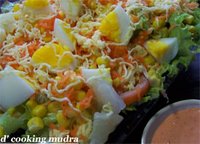
What is a Salted Duck Egg?
It is a Chinese preserved food product made by soaking duck eggs in brine or packing each egg in damp salted charcoal. In Asian supermarkets, these eggs are sometimes sold covered in a thick layer of salted charcoal paste. The eggs may also be sold with the salted paste removed, wrapped in plastic, and vacuum packed. From the salt curing process, the salted duck eggs have a briny aroma, a very liquid egg white and a yolk that is bright orange-red in colour, round, and firm in texture.
Salted duck eggs are normally boiled or steamed before being peeled and eaten as a condiment to congee or cooked with other foods as a flavorant. The egg white has a sharp and salty taste. The orange red yolk is rich, fatty, and less salty. The yolk is prized and is used in Chinese mooncakes to symbolize the moon.
Despite its name, salted duck eggs can also be made from chicken eggs though the taste and texture will be somewhat different, and the egg yolk will be less rich.
Salted eggs are also popularly sold in the Philippines. Salted egg sold in the Philippines undergo a similar process of salting as above with few variation in materials used. It is sold over the counter pre-cooked and ready to eat. The commercial salted eggs are duck eggs and always dyed red to differentiate from fresh eggs. As these are also packaged, transported and displayed in markets in egg trays used for fresh eggs.
The most popular method of processing salted eggs in the Philippines is the "Pateros" method. The resulting product tastes succulent, the saltiness delectable and "smooth-to-taste."
Oftentimes, it is sold as fast as the fresh eggs specially in the depressed areas as part of breakfast and in other households, stored as a quick meal for other household members when no prepared meal is available.
"Pateros Style"The salted egg is prepared by first admixing clay (from ant hills of termites), table salt and water in the ratio of 1:1:2 until the texture of the admixture becomes smooth and forms to a thick cake batter. The fresh eggs are individually dipped and packed in 150 pieces, in newspaper-lined 10x12x18 inch wooden box. The whole bunch lightly wrapped by newspapers to slow down dehydration. These eggs are stored indoors at room temperature over the next 12 to 14 days. That way the salt works its way into the salt uniformly in the batch. Curing can last up to 18 days but that makes very long-lasting red eggs that can last 40 days shelf life but eggs are stocked and replenished every two weeks interval so there is no need for the extra curing time.
After the two week curing, the eggs are hand cleaned with water and brush and prepared to be cooked in low fire in 50 minutes. Time counted from the first boiling of water and the immersion of 50 egg batch. the 50 egg batch is wrapped in fish net for ease of taking out from the cookware. the cookware must be big enough to accommodate the batch with 2 inch of water above the top eggs.
The cooked eggs are then colored red from dye by immersing for a few seconds the newly cooked batch to another container with lukewarm water mixed with the dye and subsequently, the batch is air dried and packed in egg trays.
Chicken eggs may be processed the same way but egg breakage can go up to 10% of the batch.
For the recipe:Basically, it's a piece of medium sized tomato (
the kind that's ripe but still crunchy) and a salted duck egg. I just combined them using my hands, just tore them apart and mix together. That's it! (",)
Well, you just make sure before making this recipe your hands are clean.
 Ingredients:
Ingredients:


